Deck 8: The Business Cycle
Question
Question
Question
Question
Question
Question
Question
Question
Question
Question
Question
Question
Question
Question
Question
Question
Question
Question
Question
Question
Question
Question
Question
Question
Question
Question
Question
Question
Question
Question
Question
Question
Question
Question
Question
Question
Question
Question
Question
Question
Question
Question
Question
Question
Question
Question
Question
Question
Question
Question
Question
Question
Question
Question
Question
Question
Question
Question
Question
Question
Question
Question
Question
Question
Question
Question
Question
Question
Question
Question
Question
Question
Question
Question
Question
Question
Question
Question
Question
Question

Unlock Deck
Sign up to unlock the cards in this deck!
Unlock Deck
Unlock Deck
1/147
Play
Full screen (f)
Deck 8: The Business Cycle
1
Greater-than-normal profit represents
A) Explicit costs minus implicit costs.
B) Payment for entrepreneurship.
C) Below-average returns to capital.
D) Exploitation of workers.
A) Explicit costs minus implicit costs.
B) Payment for entrepreneurship.
C) Below-average returns to capital.
D) Exploitation of workers.
B
2
Explicit costs
A) Include only payments to entrepreneurship.
B) Are the sum of actual monetary payments made for resources used to produce a good.
C) Include the market value of all resources used to produce a good.
D) Are the total opportunity costs of resources used to produce a good.
A) Include only payments to entrepreneurship.
B) Are the sum of actual monetary payments made for resources used to produce a good.
C) Include the market value of all resources used to produce a good.
D) Are the total opportunity costs of resources used to produce a good.
B
3
All of the following are ways a business can earn economic profits except
A) Discover new products.
B) Maximize implicit costs but not explicit costs.
C) Take above-average risks.
D) Find new and better methods of production.
A) Discover new products.
B) Maximize implicit costs but not explicit costs.
C) Take above-average risks.
D) Find new and better methods of production.
B
4
A firm that makes zero economic profits
A) Must eventually go bankrupt and exit the industry.
B) Does not cover its variable costs and should shut down in the short run.
C) Incurs an accounting loss if fixed costs are greater than variable costs.
D) Covers all its costs, including a provision for normal profit.
A) Must eventually go bankrupt and exit the industry.
B) Does not cover its variable costs and should shut down in the short run.
C) Incurs an accounting loss if fixed costs are greater than variable costs.
D) Covers all its costs, including a provision for normal profit.

Unlock Deck
Unlock for access to all 147 flashcards in this deck.
Unlock Deck
k this deck
5
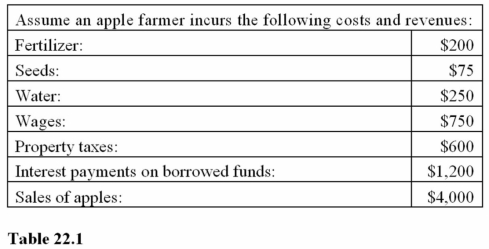 The accounting profit is equal to
The accounting profit is equal toA) $925.
B) $1,525.
C) $2,125.
D) $4,000.

Unlock Deck
Unlock for access to all 147 flashcards in this deck.
Unlock Deck
k this deck
6
The best measure of the economic cost of doing your homework is
A) The most valuable opportunity you give up when you do your homework.
B) The amount you would have to pay to get someone else to do it.
C) The economic cost plus the accounting cost of doing the homework.
D) The tuition paid for your education plus the cost of any required textbooks.
A) The most valuable opportunity you give up when you do your homework.
B) The amount you would have to pay to get someone else to do it.
C) The economic cost plus the accounting cost of doing the homework.
D) The tuition paid for your education plus the cost of any required textbooks.

Unlock Deck
Unlock for access to all 147 flashcards in this deck.
Unlock Deck
k this deck
7
Implicit costs
A) Include only payments to workers and lenders.
B) Represent actual monetary payments made for resources used to produce a good such as oil.
C) Are the costs to produce a good or service for which no direct payment is made.
D) Are the total opportunity costs of resources and inputs used to produce a good.
A) Include only payments to workers and lenders.
B) Represent actual monetary payments made for resources used to produce a good such as oil.
C) Are the costs to produce a good or service for which no direct payment is made.
D) Are the total opportunity costs of resources and inputs used to produce a good.

Unlock Deck
Unlock for access to all 147 flashcards in this deck.
Unlock Deck
k this deck
8
Which of the following is the best explanation for why individuals own small businesses?
A) Because they cannot earn a living working for corporate America.
B) To provide a product consumers want.
C) The expectation of profit.
D) To gain experience for their next job.
A) Because they cannot earn a living working for corporate America.
B) To provide a product consumers want.
C) The expectation of profit.
D) To gain experience for their next job.

Unlock Deck
Unlock for access to all 147 flashcards in this deck.
Unlock Deck
k this deck
9
Economic profit is
A) Greater than accounting profit by the amount of implicit cost.
B) Greater than accounting profit by the amount of explicit cost.
C) Less than accounting profit by the amount of implicit cost.
D) Less than accounting profit by the amount of explicit cost.
A) Greater than accounting profit by the amount of implicit cost.
B) Greater than accounting profit by the amount of explicit cost.
C) Less than accounting profit by the amount of implicit cost.
D) Less than accounting profit by the amount of explicit cost.

Unlock Deck
Unlock for access to all 147 flashcards in this deck.
Unlock Deck
k this deck
10
Which of the following should not be included when calculating accounting profit?
A) The cost of taxes.
B) The return on inventory investment.
C) The cost of rent.
D) The cost of utilities.
A) The cost of taxes.
B) The return on inventory investment.
C) The cost of rent.
D) The cost of utilities.

Unlock Deck
Unlock for access to all 147 flashcards in this deck.
Unlock Deck
k this deck
11
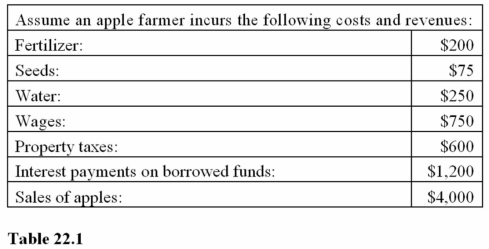 Suppose the entrepreneur could earn $1,000 as an employee elsewhere. This means the economic profit is
Suppose the entrepreneur could earn $1,000 as an employee elsewhere. This means the economic profit isA) -$925.
B) -$75.
C) -$1,000.
D) $0.

Unlock Deck
Unlock for access to all 147 flashcards in this deck.
Unlock Deck
k this deck
12
Economic profit is the difference between
A) Accounting profits and external costs.
B) Total costs and total economic costs.
C) Accounting profit and explicit costs.
D) Total revenues and total economic costs.
A) Accounting profits and external costs.
B) Total costs and total economic costs.
C) Accounting profit and explicit costs.
D) Total revenues and total economic costs.

Unlock Deck
Unlock for access to all 147 flashcards in this deck.
Unlock Deck
k this deck
13
Normal profit
A) Covers the full opportunity cost of the resources used by the firm.
B) Is an above-average rate of return.
C) Is the accounting profit earned when economic profits are greater than zero.
D) Is sufficient to induce entry into the industry.
A) Covers the full opportunity cost of the resources used by the firm.
B) Is an above-average rate of return.
C) Is the accounting profit earned when economic profits are greater than zero.
D) Is sufficient to induce entry into the industry.

Unlock Deck
Unlock for access to all 147 flashcards in this deck.
Unlock Deck
k this deck
14
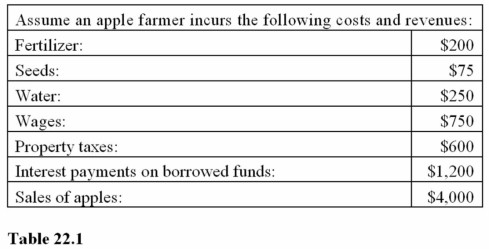 Suppose the entrepreneur could earn $1,000 as an employee elsewhere. This means the accounting profit is
Suppose the entrepreneur could earn $1,000 as an employee elsewhere. This means the accounting profit isA) $1,525.
B) $925.
C) -$75.
D) -$1,000.

Unlock Deck
Unlock for access to all 147 flashcards in this deck.
Unlock Deck
k this deck
15
In defining economic costs, economists emphasize
A) Explicit and implicit costs while accountants recognize only implicit costs.
B) Explicit and implicit costs while accountants recognize only explicit costs.
C) Only explicit costs while accountants recognize only implicit costs.
D) Only explicit costs while accountants recognize explicit and implicit costs.
A) Explicit and implicit costs while accountants recognize only implicit costs.
B) Explicit and implicit costs while accountants recognize only explicit costs.
C) Only explicit costs while accountants recognize only implicit costs.
D) Only explicit costs while accountants recognize explicit and implicit costs.

Unlock Deck
Unlock for access to all 147 flashcards in this deck.
Unlock Deck
k this deck
16
The profit motive can encourage businesses to do all of the following except
A) Pollute the environment.
B) Restrict competition.
C) Provide unsafe working conditions.
D) Maximize social welfare.
A) Pollute the environment.
B) Restrict competition.
C) Provide unsafe working conditions.
D) Maximize social welfare.

Unlock Deck
Unlock for access to all 147 flashcards in this deck.
Unlock Deck
k this deck
17
Normal profit implies that
A) Economic profit must be positive.
B) Economic profit must be negative.
C) The factors employed are earning as much as they could in the best alternative employment.
D) Firms will expand their scale of production.
A) Economic profit must be positive.
B) Economic profit must be negative.
C) The factors employed are earning as much as they could in the best alternative employment.
D) Firms will expand their scale of production.

Unlock Deck
Unlock for access to all 147 flashcards in this deck.
Unlock Deck
k this deck
18
Economists assume the principal motivation of producers is
A) Psychological gratification.
B) Social status.
C) Profit.
D) Their preference for being "their own person."
A) Psychological gratification.
B) Social status.
C) Profit.
D) Their preference for being "their own person."

Unlock Deck
Unlock for access to all 147 flashcards in this deck.
Unlock Deck
k this deck
19
Profit
A) Is the difference between total revenue and total cost.
B) Is the difference between variable costs and fixed costs.
C) Is always a number greater than zero.
D) Must be reported to Wall Street quarterly.
A) Is the difference between total revenue and total cost.
B) Is the difference between variable costs and fixed costs.
C) Is always a number greater than zero.
D) Must be reported to Wall Street quarterly.

Unlock Deck
Unlock for access to all 147 flashcards in this deck.
Unlock Deck
k this deck
20
Accounting costs and economic costs differ because
A) Accounting costs exceed economic costs whenever any factor is not paid an explicit wage.
B) Accounting costs include implicit costs, and economic costs do not.
C) Economic costs include the opportunity costs of all resources used, while accounting costs include actual dollar outlays.
D) Accounting costs include explicit costs, and economic costs do not.
A) Accounting costs exceed economic costs whenever any factor is not paid an explicit wage.
B) Accounting costs include implicit costs, and economic costs do not.
C) Economic costs include the opportunity costs of all resources used, while accounting costs include actual dollar outlays.
D) Accounting costs include explicit costs, and economic costs do not.

Unlock Deck
Unlock for access to all 147 flashcards in this deck.
Unlock Deck
k this deck
21
In which of the following types of markets does a single firm have the most market power?
A) Perfect competition.
B) Monopolistic competition.
C) Oligopoly.
D) Monopoly.
A) Perfect competition.
B) Monopolistic competition.
C) Oligopoly.
D) Monopoly.

Unlock Deck
Unlock for access to all 147 flashcards in this deck.
Unlock Deck
k this deck
22
Suppose a firm has an annual budget of $200,000 in wages and salaries, $75,000 in materials, $30,000 in new equipment, $20,000 in rented property, and $35,000 in interest costs on capital. The owner/manager does not choose to pay himself, but he could receive income of $90,000 by working elsewhere. The firm earns revenues of $360,000 per year. To receive a normal profit, the firm described above would have to
A) Experience $10,000 less in cost.
B) Receive $90,000 more in revenue.
C) Receive $10,000 more in revenue.
D) Do nothing since it already earns a normal profit.
A) Experience $10,000 less in cost.
B) Receive $90,000 more in revenue.
C) Receive $10,000 more in revenue.
D) Do nothing since it already earns a normal profit.

Unlock Deck
Unlock for access to all 147 flashcards in this deck.
Unlock Deck
k this deck
23
The $600 paid in property taxes counts as
A) An implicit cost.
B) A normal cost.
C) A variable cost.
D) An explicit cost.
A) An implicit cost.
B) A normal cost.
C) A variable cost.
D) An explicit cost.

Unlock Deck
Unlock for access to all 147 flashcards in this deck.
Unlock Deck
k this deck
24
Perfect competition is a situation in which
A) Every year, owners are likely to earn economic profits.
B) Every year, owners are likely to earn economic losses.
C) There are many firms and several buyers or sellers have market power.
D) There are many firms and no buyer or seller has market power.
A) Every year, owners are likely to earn economic profits.
B) Every year, owners are likely to earn economic losses.
C) There are many firms and several buyers or sellers have market power.
D) There are many firms and no buyer or seller has market power.

Unlock Deck
Unlock for access to all 147 flashcards in this deck.
Unlock Deck
k this deck
25
Suppose a firm has an annual budget of $200,000 in wages and salaries, $75,000 in materials, $30,000 in new equipment, $20,000 in rented property, and $35,000 in interest costs on capital. The owner/manager does not choose to pay himself, but he could receive income of $90,000 by working elsewhere. The firm earns revenues of $360,000 per year. What is the accounting profit for the firm described above?
A) -$90,000.
B) $0.
C) $90,000.
D) $200,000.
A) -$90,000.
B) $0.
C) $90,000.
D) $200,000.

Unlock Deck
Unlock for access to all 147 flashcards in this deck.
Unlock Deck
k this deck
26
Suppose a firm has an annual budget of $200,000 in wages and salaries, $75,000 in materials, $30,000 in new equipment, $20,000 in rented property, and $35,000 in interest costs on capital. The owner/manager does not choose to pay himself, but he could receive income of $90,000 by working elsewhere. The firm earns revenues of $360,000 per year. What are the annual economic costs for the firm described above?
A) $450,000.
B) $120,000.
C) $90,000.
D) $360,000.
A) $450,000.
B) $120,000.
C) $90,000.
D) $360,000.

Unlock Deck
Unlock for access to all 147 flashcards in this deck.
Unlock Deck
k this deck
27
If a firm can change market prices by altering its output, then it
A) Has market power.
B) Faces a horizontal demand curve.
C) Is a price taker.
D) Is a competitive firm.
A) Has market power.
B) Faces a horizontal demand curve.
C) Is a price taker.
D) Is a competitive firm.

Unlock Deck
Unlock for access to all 147 flashcards in this deck.
Unlock Deck
k this deck
28
Market structure is determined by the
A) Annual revenue, costs, and profits for an industry.
B) Number and relative size of the firms in an industry.
C) Amount of compensation given to the CEOs.
D) Price charged for the good or service produced.
A) Annual revenue, costs, and profits for an industry.
B) Number and relative size of the firms in an industry.
C) Amount of compensation given to the CEOs.
D) Price charged for the good or service produced.

Unlock Deck
Unlock for access to all 147 flashcards in this deck.
Unlock Deck
k this deck
29
The perfectly competitive market structure includes all of the following except
A) Many firms.
B) Identical products.
C) Large advertising budgets.
D) Low entry barriers.
A) Many firms.
B) Identical products.
C) Large advertising budgets.
D) Low entry barriers.

Unlock Deck
Unlock for access to all 147 flashcards in this deck.
Unlock Deck
k this deck
30
Assuming the entrepreneur does not pay herself, the $1,000 she could earn as an employee elsewhere is considered
A) An implicit cost.
B) An explicit cost.
C) A fixed cost.
D) A variable cost.
A) An implicit cost.
B) An explicit cost.
C) A fixed cost.
D) A variable cost.

Unlock Deck
Unlock for access to all 147 flashcards in this deck.
Unlock Deck
k this deck
31
Suppose a firm has an annual budget of $200,000 in wages and salaries, $75,000 in materials, $30,000 in new equipment, $20,000 in rented property, and $35,000 in interest costs on capital. The owner/manager does not choose to pay himself, but he could receive income of $90,000 by working elsewhere. The firm earns revenues of $360,000 per year. What are the annual explicit costs for the firm described above?
A) $450,000.
B) $160,000.
C) $90,000.
D) $360,000.
A) $450,000.
B) $160,000.
C) $90,000.
D) $360,000.

Unlock Deck
Unlock for access to all 147 flashcards in this deck.
Unlock Deck
k this deck
32
Adam Weed is the owner/operator of a flower shop. Last year he earned $250,000 in total revenue. His explicit costs were $175,000 paid to his employees and suppliers (assume that this amount represents the total opportunity cost of these resources). During the year he received three offers to work for other flower shops with the highest offer being $75,000 per year. Which of the following is true about Adam's accounting and economic profit?
A) Accounting profit = $75,000; economic profit = $0.
B) Accounting profit = $175,000; economic profit = $75,000.
C) Accounting profit = $75,000; economic profit = negative $100,000.
D) Accounting profit = $0; economic profit = negative $75,000.
A) Accounting profit = $75,000; economic profit = $0.
B) Accounting profit = $175,000; economic profit = $75,000.
C) Accounting profit = $75,000; economic profit = negative $100,000.
D) Accounting profit = $0; economic profit = negative $75,000.

Unlock Deck
Unlock for access to all 147 flashcards in this deck.
Unlock Deck
k this deck
33
A monopoly occurs when
A) There is only one producer of a good or service.
B) There is only one buyer of a good or service.
C) Owners take on additional risk and earn huge profits.
D) Companies become greedy and raise the price of a good or service.
A) There is only one producer of a good or service.
B) There is only one buyer of a good or service.
C) Owners take on additional risk and earn huge profits.
D) Companies become greedy and raise the price of a good or service.

Unlock Deck
Unlock for access to all 147 flashcards in this deck.
Unlock Deck
k this deck
34
Lashondra is the owner/operator of an interior design firm. Last year she earned $400,000 in total revenue. Her explicit costs were $200,000 (assume that this amount represents the total opportunity cost of these resources). During the year she received offers to work for other design firms. One offer would have paid her $120,000 per year and the other would have paid her $130,000 per year. Lashondra's economic profit is equal to
A) -$50,000.
B) $70,000.
C) $0.
D) $200,000.
A) -$50,000.
B) $70,000.
C) $0.
D) $200,000.

Unlock Deck
Unlock for access to all 147 flashcards in this deck.
Unlock Deck
k this deck
35
Suppose a firm has an annual budget of $200,000 in wages and salaries, $75,000 in materials, $30,000 in new equipment, $20,000 in rented property, and $35,000 in interest costs on capital. The owner/manager does not choose to pay himself, but he could receive income of $90,000 by working elsewhere. The firm earns revenues of $360,000 per year. What are the annual implicit costs for the firm described above?
A) $450,000.
B) $160,000.
C) $90,000.
D) $360,000.
A) $450,000.
B) $160,000.
C) $90,000.
D) $360,000.

Unlock Deck
Unlock for access to all 147 flashcards in this deck.
Unlock Deck
k this deck
36
Suppose a firm has an annual budget of $200,000 in wages and salaries, $75,000 in materials, $30,000 in new equipment, $20,000 in rented property, and $35,000 in interest costs on capital. The owner/manager does not choose to pay himself, but he could receive income of $90,000 by working elsewhere. The firm earns revenues of $360,000 per year. What is the economic profit for the firm described above?
A) -$90,000.
B) $0.
C) $90,000.
D) $200,000.
A) -$90,000.
B) $0.
C) $90,000.
D) $200,000.

Unlock Deck
Unlock for access to all 147 flashcards in this deck.
Unlock Deck
k this deck
37
Megan used to work at the local pizzeria for $15,000 per year but quit to start her own deli. To buy the necessary equipment, she withdrew $20,000 from her inheritance (which paid 8 percent interest). Last year she paid $25,000 for ingredients and $500 per month rent but had revenue of $50,000. She asked her dad the accountant and her mom the economist to calculate her profit for her.
A) Dad says she lost $11,000 and Mom says she lost $26,000.
B) Dad says her profit is $31,000 and Mom says her profit is $16,600.
C) Dad says her profit is $9,000 and Mom says she lost $6,000.
D) Dad says her profit is $9,000 and Mom says her profit is $2,400.
A) Dad says she lost $11,000 and Mom says she lost $26,000.
B) Dad says her profit is $31,000 and Mom says her profit is $16,600.
C) Dad says her profit is $9,000 and Mom says she lost $6,000.
D) Dad says her profit is $9,000 and Mom says her profit is $2,400.

Unlock Deck
Unlock for access to all 147 flashcards in this deck.
Unlock Deck
k this deck
38
Entrepreneurship
A) Always involves greater rewards than risks.
B) Can result in economic losses.
C) Cannot earn an economic profit.
D) Occurs in small businesses, but not large corporations.
A) Always involves greater rewards than risks.
B) Can result in economic losses.
C) Cannot earn an economic profit.
D) Occurs in small businesses, but not large corporations.

Unlock Deck
Unlock for access to all 147 flashcards in this deck.
Unlock Deck
k this deck
39
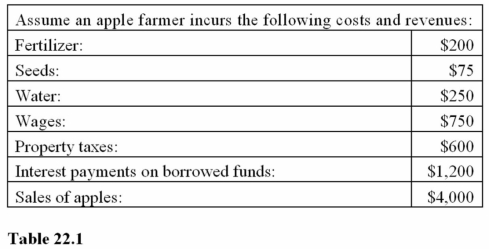 Suppose the entrepreneur could earn $800 as an employee elsewhere. This means the entrepreneur is earning
Suppose the entrepreneur could earn $800 as an employee elsewhere. This means the entrepreneur is earningA) Breakeven profits.
B) Economic losses.
C) Economic profits.
D) Accounting losses.

Unlock Deck
Unlock for access to all 147 flashcards in this deck.
Unlock Deck
k this deck
40
When a producer can control the market price for the good it sells, the producer
A) Is an entrepreneur.
B) Is certain to make a profit.
C) Has market power.
D) Is a perfectly competitive firm.
A) Is an entrepreneur.
B) Is certain to make a profit.
C) Has market power.
D) Is a perfectly competitive firm.

Unlock Deck
Unlock for access to all 147 flashcards in this deck.
Unlock Deck
k this deck
41
If the equilibrium price in a perfectly competitive market for walnuts is $4.99 per pound, then an individual firm in this market can
A) Not sell additional walnuts unless the firm lowers its price.
B) Not sell additional walnuts at any price because the market is at equilibrium.
C) Sell an additional pound of walnuts at $4.99.
D) Sell more only by increasing its advertising budget.
A) Not sell additional walnuts unless the firm lowers its price.
B) Not sell additional walnuts at any price because the market is at equilibrium.
C) Sell an additional pound of walnuts at $4.99.
D) Sell more only by increasing its advertising budget.

Unlock Deck
Unlock for access to all 147 flashcards in this deck.
Unlock Deck
k this deck
42
Which of the following industries is perfectly competitive?
A) Autos.
B) Cell phone service.
C) Wholesale fresh flowers.
D) Fast-food restaurants.
A) Autos.
B) Cell phone service.
C) Wholesale fresh flowers.
D) Fast-food restaurants.

Unlock Deck
Unlock for access to all 147 flashcards in this deck.
Unlock Deck
k this deck
43
The short run is the time period
A) Over which an investment decision can be made.
B) Necessary so that profits can be earned from production.
C) In which some costs are fixed.
D) In which only the amount of capital may be altered.
A) Over which an investment decision can be made.
B) Necessary so that profits can be earned from production.
C) In which some costs are fixed.
D) In which only the amount of capital may be altered.

Unlock Deck
Unlock for access to all 147 flashcards in this deck.
Unlock Deck
k this deck
44
A competitive firm
A) Has the market power to compete effectively.
B) Is large enough relative to the market to be taken into account by competitors.
C) Confronts a downward-sloping firm demand curve.
D) Is a price taker.
A) Has the market power to compete effectively.
B) Is large enough relative to the market to be taken into account by competitors.
C) Confronts a downward-sloping firm demand curve.
D) Is a price taker.

Unlock Deck
Unlock for access to all 147 flashcards in this deck.
Unlock Deck
k this deck
45
The fact that a perfectly competitive firm's total revenue curve is an upward-sloping straight line implies that
A) The total profit curve is also an upward-sloping straight line.
B) Product price is constant at all levels of output.
C) Product price decreases as output increases, and demand is elastic.
D) Product price increases at all output levels.
A) The total profit curve is also an upward-sloping straight line.
B) Product price is constant at all levels of output.
C) Product price decreases as output increases, and demand is elastic.
D) Product price increases at all output levels.

Unlock Deck
Unlock for access to all 147 flashcards in this deck.
Unlock Deck
k this deck
46
The demand curve for each perfectly competitive firm is
A) Downward-sloping.
B) Horizontal.
C) Vertical.
D) Upward-sloping.
A) Downward-sloping.
B) Horizontal.
C) Vertical.
D) Upward-sloping.

Unlock Deck
Unlock for access to all 147 flashcards in this deck.
Unlock Deck
k this deck
47
In making a production decision, an entrepreneur
A) Decides whether to enter or exit the market.
B) Decides what level of output will maximize profits.
C) Determines plants and equipment.
D) Can change both fixed and variable inputs.
A) Decides whether to enter or exit the market.
B) Decides what level of output will maximize profits.
C) Determines plants and equipment.
D) Can change both fixed and variable inputs.

Unlock Deck
Unlock for access to all 147 flashcards in this deck.
Unlock Deck
k this deck
48
A firm maximizes total profit when
A) Total costs exceed total revenue by the largest amount.
B) Total revenues are maximized.
C) Marginal costs are greater than marginal revenues.
D) Total revenue exceeds total cost by the greatest amount.
A) Total costs exceed total revenue by the largest amount.
B) Total revenues are maximized.
C) Marginal costs are greater than marginal revenues.
D) Total revenue exceeds total cost by the greatest amount.

Unlock Deck
Unlock for access to all 147 flashcards in this deck.
Unlock Deck
k this deck
49
Fixed costs
A) Increase with the level of production in the short run.
B) Can be altered in the short run but not in the long run.
C) Increase as we move from the short run to the long run.
D) Are constant in the short run.
A) Increase with the level of production in the short run.
B) Can be altered in the short run but not in the long run.
C) Increase as we move from the short run to the long run.
D) Are constant in the short run.

Unlock Deck
Unlock for access to all 147 flashcards in this deck.
Unlock Deck
k this deck
50
The demand curve confronting a competitive firm is
A) Horizontal, as is market demand.
B) Horizontal, while market demand is downward-sloping.
C) Downward-sloping, while market demand is flat.
D) Downward-sloping, as is market demand.
A) Horizontal, as is market demand.
B) Horizontal, while market demand is downward-sloping.
C) Downward-sloping, while market demand is flat.
D) Downward-sloping, as is market demand.

Unlock Deck
Unlock for access to all 147 flashcards in this deck.
Unlock Deck
k this deck
51
Which of the following is a production decision?
A) How much output the firm should produce in the long run.
B) Whether the firm should shut down or produce.
C) Whether the firm should exit or enter the market.
D) Whether the firm should merge with one of its rivals.
A) How much output the firm should produce in the long run.
B) Whether the firm should shut down or produce.
C) Whether the firm should exit or enter the market.
D) Whether the firm should merge with one of its rivals.

Unlock Deck
Unlock for access to all 147 flashcards in this deck.
Unlock Deck
k this deck
52
A production decision involves choosing
A) The amount of plants and equipment and is a short-run decision.
B) The amount of plants and equipment and is a long-run decision.
C) A rate of output and is a short-run decision.
D) A rate of output and is a long-run decision.
A) The amount of plants and equipment and is a short-run decision.
B) The amount of plants and equipment and is a long-run decision.
C) A rate of output and is a short-run decision.
D) A rate of output and is a long-run decision.

Unlock Deck
Unlock for access to all 147 flashcards in this deck.
Unlock Deck
k this deck
53
A perfectly competitive firm is a price taker because
A) The price of the product is determined by many buyers and sellers.
B) It has market power.
C) Market supply is upward-sloping.
D) Its products are differentiated.
A) The price of the product is determined by many buyers and sellers.
B) It has market power.
C) Market supply is upward-sloping.
D) Its products are differentiated.

Unlock Deck
Unlock for access to all 147 flashcards in this deck.
Unlock Deck
k this deck
54
The market price for T-shirts sold in a perfectly competitive market is determined by
A) The largest firm in the industry.
B) Supply and demand.
C) Government regulation.
D) Strategic interaction.
A) The largest firm in the industry.
B) Supply and demand.
C) Government regulation.
D) Strategic interaction.

Unlock Deck
Unlock for access to all 147 flashcards in this deck.
Unlock Deck
k this deck
55
In order to sell additional units of their products, competitive firms must
A) Increase their advertising.
B) Lower their price.
C) Cut their expenses.
D) Increase output.
A) Increase their advertising.
B) Lower their price.
C) Cut their expenses.
D) Increase output.

Unlock Deck
Unlock for access to all 147 flashcards in this deck.
Unlock Deck
k this deck
56
If a perfectly competitive firm wanted to maximize its total revenues, it would produce
A) The output where MC equals price.
B) As much as it is capable of producing.
C) The output where the ATC curve is at a minimum.
D) The output where the marginal cost curve is at a minimum.
A) The output where MC equals price.
B) As much as it is capable of producing.
C) The output where the ATC curve is at a minimum.
D) The output where the marginal cost curve is at a minimum.

Unlock Deck
Unlock for access to all 147 flashcards in this deck.
Unlock Deck
k this deck
57
Competitive firms cannot individually affect market price because
A) There is an infinite demand for their goods.
B) Demand is perfectly inelastic for their goods.
C) Their individual production is insignificant relative to the production of the industry.
D) The government exercises control over the market power of competitive firms.
A) There is an infinite demand for their goods.
B) Demand is perfectly inelastic for their goods.
C) Their individual production is insignificant relative to the production of the industry.
D) The government exercises control over the market power of competitive firms.

Unlock Deck
Unlock for access to all 147 flashcards in this deck.
Unlock Deck
k this deck
58
A firm's total revenue can be determined by
A) Price times quantity.
B) Profits minus costs.
C) Total costs minus variable costs.
D) Fixed costs minus quantity.
A) Price times quantity.
B) Profits minus costs.
C) Total costs minus variable costs.
D) Fixed costs minus quantity.

Unlock Deck
Unlock for access to all 147 flashcards in this deck.
Unlock Deck
k this deck
59
The demand curve confronting a competitive firm
A) Equals the marginal revenue curve.
B) Is horizontal, as is the market demand curve.
C) Slopes downward, while the market demand curve is horizontal.
D) Slopes downward, and the marginal revenue curve is below it.
A) Equals the marginal revenue curve.
B) Is horizontal, as is the market demand curve.
C) Slopes downward, while the market demand curve is horizontal.
D) Slopes downward, and the marginal revenue curve is below it.

Unlock Deck
Unlock for access to all 147 flashcards in this deck.
Unlock Deck
k this deck
60
Which of the following characterizes a competitive market?
A) A downward-sloping demand curve for the firm.
B) A vertical demand curve facing each firm in the market.
C) Some of the firms sell at a price above the market equilibrium price.
D) A downward-sloping demand curve for the market.
A) A downward-sloping demand curve for the firm.
B) A vertical demand curve facing each firm in the market.
C) Some of the firms sell at a price above the market equilibrium price.
D) A downward-sloping demand curve for the market.

Unlock Deck
Unlock for access to all 147 flashcards in this deck.
Unlock Deck
k this deck
61
The difference between the total revenue and total cost curves at a given output is equal to
A) Total profit.
B) Profit per unit.
C) Average revenue.
D) Average total cost.
A) Total profit.
B) Profit per unit.
C) Average revenue.
D) Average total cost.

Unlock Deck
Unlock for access to all 147 flashcards in this deck.
Unlock Deck
k this deck
62
If price is less than marginal cost, a perfectly competitive firm should decrease output because
A) Marginal costs are increasing.
B) Total revenues are decreasing.
C) The firm is producing units that cost more to produce than the firm receives in revenue, thus reducing profits (or increasing losses).
D) Marginal revenue is decreasing.
A) Marginal costs are increasing.
B) Total revenues are decreasing.
C) The firm is producing units that cost more to produce than the firm receives in revenue, thus reducing profits (or increasing losses).
D) Marginal revenue is decreasing.

Unlock Deck
Unlock for access to all 147 flashcards in this deck.
Unlock Deck
k this deck
63
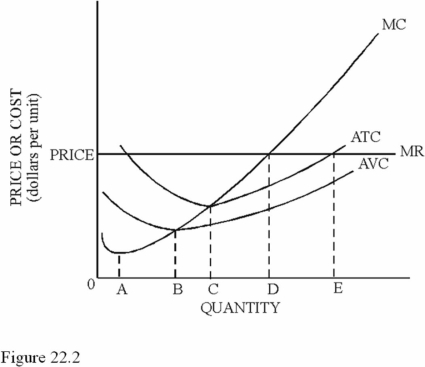 Refer to Figure 22.3 At quantity level B
Refer to Figure 22.3 At quantity level BA) The company is maximizing profit.
B) Marginal cost is greater than marginal revenue, so it should cut production.
C) The company is minimizing loss.
D) Marginal revenue is greater than marginal cost, so the firm should expand production.

Unlock Deck
Unlock for access to all 147 flashcards in this deck.
Unlock Deck
k this deck
64
If diminishing returns exist, then
A) Each unit produced will cost incrementally less.
B) Each unit produced will cost incrementally more.
C) The total cost curve will be flat.
D) The total cost curve will be negatively sloped.
A) Each unit produced will cost incrementally less.
B) Each unit produced will cost incrementally more.
C) The total cost curve will be flat.
D) The total cost curve will be negatively sloped.

Unlock Deck
Unlock for access to all 147 flashcards in this deck.
Unlock Deck
k this deck
65
A perfectly competitive firm should expand output when
A) P < ATC.
B) P > ATC.
C) P < MC.
D) P > MC.
A) P < ATC.
B) P > ATC.
C) P < MC.
D) P > MC.

Unlock Deck
Unlock for access to all 147 flashcards in this deck.
Unlock Deck
k this deck
66
For the perfectly competitive firm, the marginal revenue is always
A) Increasing.
B) Constant.
C) Equal to average total cost.
D) Decreasing.
A) Increasing.
B) Constant.
C) Equal to average total cost.
D) Decreasing.

Unlock Deck
Unlock for access to all 147 flashcards in this deck.
Unlock Deck
k this deck
67
If a perfectly competitive firm is producing a rate of output at which MC exceeds price, then the firm
A) Must have an economic loss.
B) Can increase its profit by increasing output.
C) Can increase its profit by decreasing output.
D) Is maximizing profit.
A) Must have an economic loss.
B) Can increase its profit by increasing output.
C) Can increase its profit by decreasing output.
D) Is maximizing profit.

Unlock Deck
Unlock for access to all 147 flashcards in this deck.
Unlock Deck
k this deck
68
When the short-run marginal cost curve is upward-sloping,
A) The average total cost curve is upward-sloping.
B) The average total cost curve is above the marginal cost curve.
C) Diminishing returns occurs with greater output.
D) There are diseconomies of scale.
A) The average total cost curve is upward-sloping.
B) The average total cost curve is above the marginal cost curve.
C) Diminishing returns occurs with greater output.
D) There are diseconomies of scale.

Unlock Deck
Unlock for access to all 147 flashcards in this deck.
Unlock Deck
k this deck
69
If price is greater than marginal cost, a perfectly competitive firm should increase output because
A) Marginal costs are increasing.
B) Additional units of output will add to the firm's profits (or reduce losses).
C) The price it receives for its product is increasing.
D) Total revenues would increase.
A) Marginal costs are increasing.
B) Additional units of output will add to the firm's profits (or reduce losses).
C) The price it receives for its product is increasing.
D) Total revenues would increase.

Unlock Deck
Unlock for access to all 147 flashcards in this deck.
Unlock Deck
k this deck
70
 Refer to the data in Figure 22.1. The profit-maximizing output for this firm is
Refer to the data in Figure 22.1. The profit-maximizing output for this firm isA) 100 units.
B) Above 280 units.
C) 280 units.
D) 200 units.

Unlock Deck
Unlock for access to all 147 flashcards in this deck.
Unlock Deck
k this deck
71
Profit per unit is equal to
A) TR - TC.
B) P - MR.
C) P - ATC.
D) TR - ATC.
A) TR - TC.
B) P - MR.
C) P - ATC.
D) TR - ATC.

Unlock Deck
Unlock for access to all 147 flashcards in this deck.
Unlock Deck
k this deck
72
Which of the following represents the change in total cost that results from a one-unit increase in production?
A) Marginal profit.
B) Total revenue.
C) Marginal cost.
D) Marginal revenue.
A) Marginal profit.
B) Total revenue.
C) Marginal cost.
D) Marginal revenue.

Unlock Deck
Unlock for access to all 147 flashcards in this deck.
Unlock Deck
k this deck
73
Short-run profits are maximized at the rate of output where
A) Average total costs are minimized.
B) Total revenue is maximized.
C) Marginal revenue is zero.
D) Marginal revenue is equal to marginal cost.
A) Average total costs are minimized.
B) Total revenue is maximized.
C) Marginal revenue is zero.
D) Marginal revenue is equal to marginal cost.

Unlock Deck
Unlock for access to all 147 flashcards in this deck.
Unlock Deck
k this deck
74
Marginal revenue is the change in
A) Total revenue when output is changed.
B) Total revenue when price is changed.
C) Average revenue when output is changed.
D) Average revenue when price is changed.
A) Total revenue when output is changed.
B) Total revenue when price is changed.
C) Average revenue when output is changed.
D) Average revenue when price is changed.

Unlock Deck
Unlock for access to all 147 flashcards in this deck.
Unlock Deck
k this deck
75
A perfectly competitive firm will maximize profits by choosing an output level where
A) Price is greater than marginal cost.
B) Price equals marginal cost.
C) Price equals total cost.
D) Price is greater than total cost.
A) Price is greater than marginal cost.
B) Price equals marginal cost.
C) Price equals total cost.
D) Price is greater than total cost.

Unlock Deck
Unlock for access to all 147 flashcards in this deck.
Unlock Deck
k this deck
76
For perfectly competitive firms, price
A) Is greater than marginal revenue.
B) Is equal to marginal revenue.
C) Is less than marginal revenue.
D) And marginal revenue are not related.
A) Is greater than marginal revenue.
B) Is equal to marginal revenue.
C) Is less than marginal revenue.
D) And marginal revenue are not related.

Unlock Deck
Unlock for access to all 147 flashcards in this deck.
Unlock Deck
k this deck
77
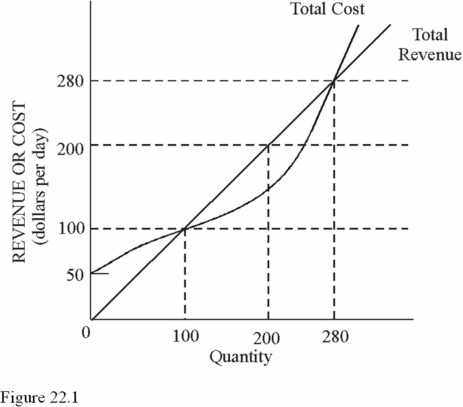 Refer to the data in Figure 22.1. The price of this good
Refer to the data in Figure 22.1. The price of this goodA) Is $50 per unit.
B) Is $1 per unit.
C) Is $100 per unit.
D) Varies as output changes.

Unlock Deck
Unlock for access to all 147 flashcards in this deck.
Unlock Deck
k this deck
78
Which of the following is generally a fixed cost?
A) Property taxes on land used in production.
B) Wages.
C) Profit taxes.
D) Utilities.
A) Property taxes on land used in production.
B) Wages.
C) Profit taxes.
D) Utilities.

Unlock Deck
Unlock for access to all 147 flashcards in this deck.
Unlock Deck
k this deck
79
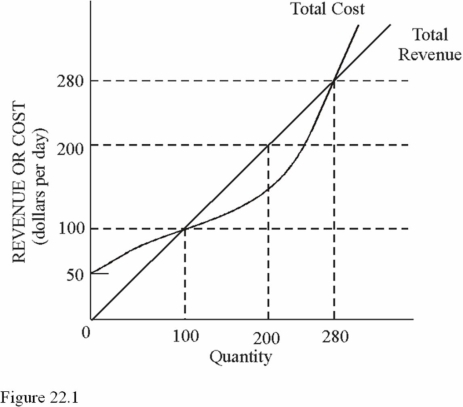 Refer to the data in Figure 22.1. The shape of the total revenue curve indicates that the price of this good
Refer to the data in Figure 22.1. The shape of the total revenue curve indicates that the price of this goodA) Falls as output rises.
B) Rises as output rises.
C) Stays the same as output rises.
D) Falls at first as output rises, but then rises as output rises.

Unlock Deck
Unlock for access to all 147 flashcards in this deck.
Unlock Deck
k this deck
80
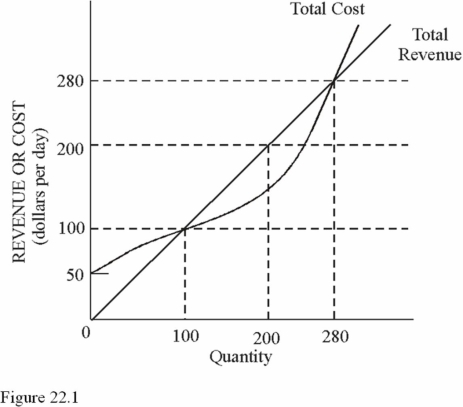 Refer to the data in Figure 22.1. The total fixed costs for this firm are approximately
Refer to the data in Figure 22.1. The total fixed costs for this firm are approximatelyA) $50.
B) $100.
C) $600.
D) $200.

Unlock Deck
Unlock for access to all 147 flashcards in this deck.
Unlock Deck
k this deck



